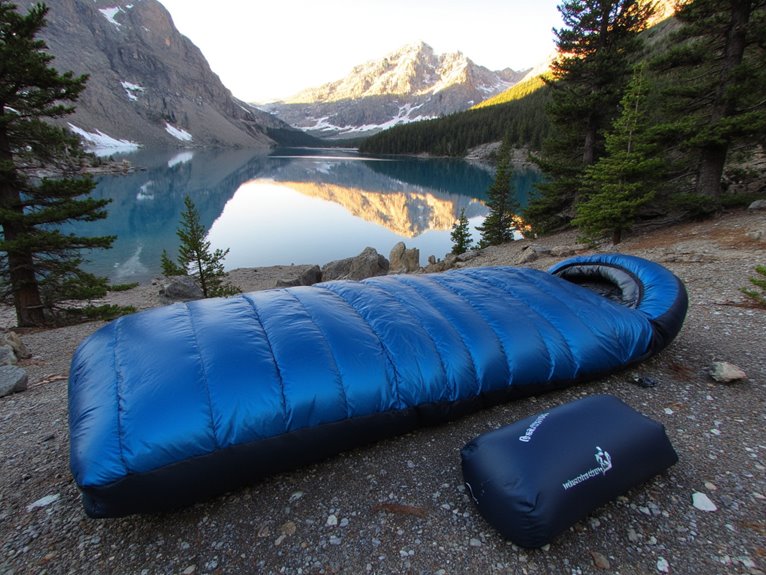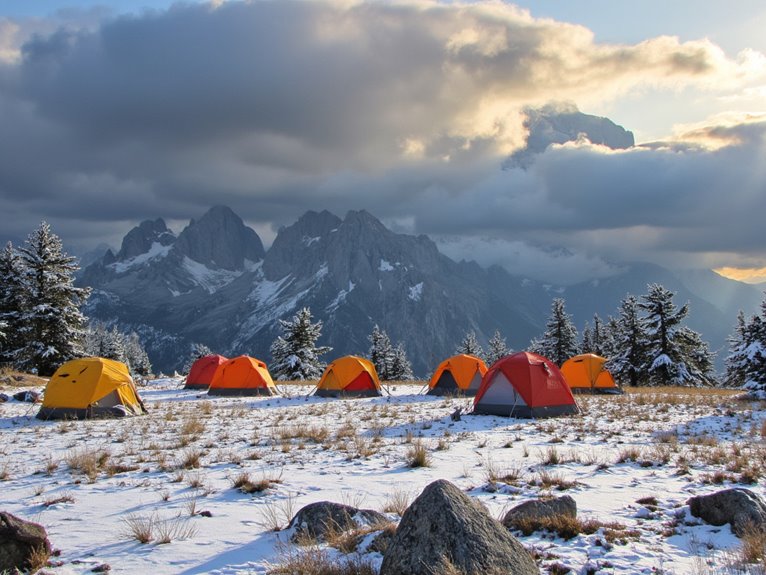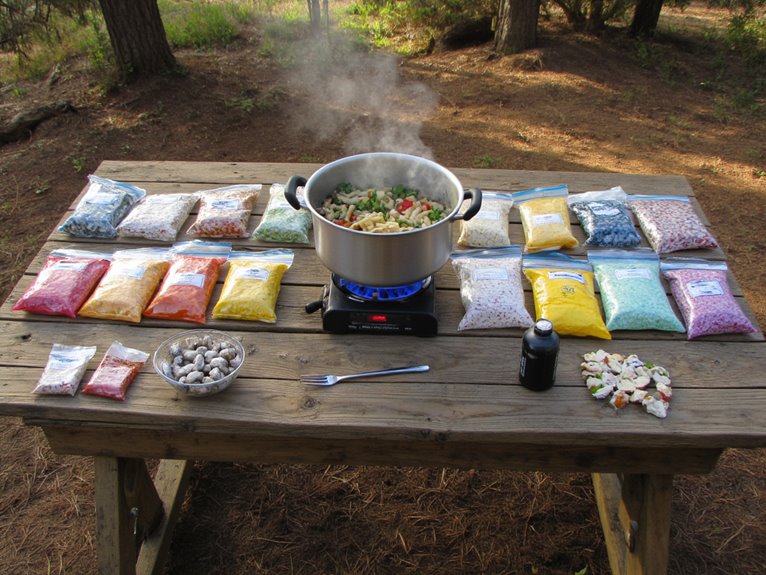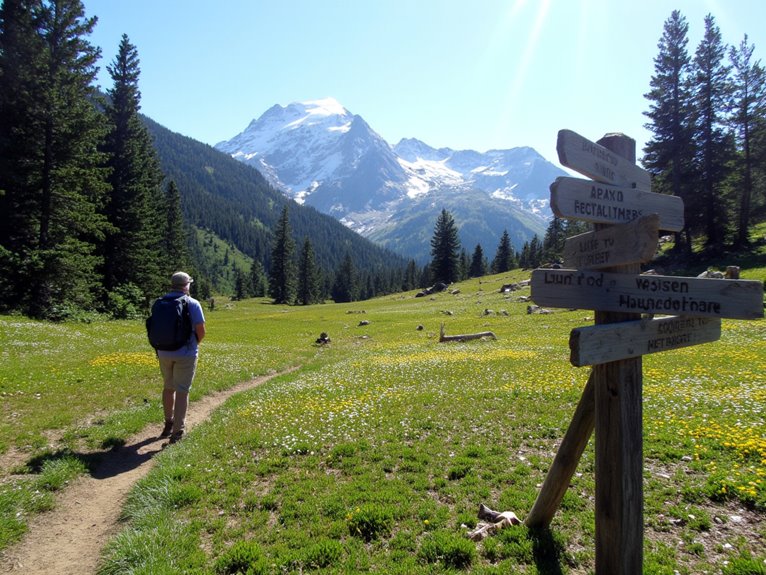How to Choose the Best Sleeping Bag for Your Backpacking Trip
You’ll need to evaluate five critical factors when choosing a backpacking sleeping bag. First, add 25-30°F to manufacturer temperature ratings for real-world conditions. Down insulation offers superior warmth-to-weight ratios and compressibility, while synthetic fills retain warmth when wet at lower cost. Target 1-3 pounds for ultralight options or 2-4 pounds for standard bags. Mummy shapes maximize thermal efficiency through snug fits. Balance your budget against essential features, and explore the detailed considerations below.
We are supported by our audience. When you purchase through links on our site, we may earn an affiliate commission, at no extra cost for you. Learn more. Last update on 7th December 2025 / Images from Amazon Product Advertising API.
Notable Insights
- Add 25-30°F to manufacturer temperature ratings and choose based on the coldest conditions you’ll encounter.
- Down bags offer superior warmth-to-weight ratio and compressibility, while synthetic bags retain warmth when wet.
- Target 1-3 pounds for ultralight bags or 2-4 pounds for standard bags to balance weight and warmth.
- Choose mummy bags for maximum thermal efficiency or semi-rectangular for more movement while sleeping.
- Balance your budget by prioritizing essential features and shopping sales for previous season models.
Understanding Temperature Ratings and Climate Requirements
When selecting a sleeping bag for backpacking, understanding temperature ratings serves as your most critical decision-making tool.
The ISO 23537 standard establishes three distinct temperature benchmarks through controlled testing. The Comfort rating indicates where you’ll sleep warmly without feeling cold. The Limit rating represents the lowest temperature for safe sleep with minimal discomfort. The Extreme rating marks survival temperature—not comfort.
Understanding ISO 23537’s three temperature ratings—Comfort, Limit, and Extreme—ensures you select the right sleeping bag for your backpacking conditions.
Your usage scenarios determine which rating matters most. Choose Comfort ratings for mild conditions or if you’re cold-sensitive.
Select Limit ratings for experienced backpackers willing to add layers in colder climates. Extreme ratings apply only to emergency situations.
Match your bag’s rating to expected nighttime lows, factoring in your personal metabolism and sleep preferences for maximum warmth. For true comfort levels, users should add 25-30°F to the manufacturer’s temperature ratings to account for real-world conditions and individual variance.
Comparing Down vs. Synthetic Insulation Options
The insulation type inside your sleeping bag determines its performance across every critical backpacking metric—weight, packability, warmth retention, and moisture management.
Down insulation delivers superior warmth-to-weight ratios and compressibility, making it ideal for ultralight backpacking. You’ll get decades of use with proper care. However, down loses insulating power when wet, despite modern hydrophobic treatments.
Synthetic insulation costs less upfront and maintains warmth when damp. It requires minimal maintenance and performs reliably in wet conditions. The trade-off is increased weight and bulk for equivalent warmth levels.
Your choice depends on trip conditions and priorities. Choose down for dry climates where weight matters most. Select synthetic for wet environments or budget-conscious purchases requiring low maintenance. Down insulation also has an 18 times less climate impact than polyester fill, making it the more environmentally sustainable choice.
Evaluating Weight and Pack Size Considerations
How much should your sleeping bag weigh, and will it fit in your pack? Your bag should weigh 2-4 pounds for standard backpacking or 1-3 pounds for ultralight trips. This represents your heaviest sleep system component, affecting overall weight distribution across your pack.
Your sleeping bag will be your pack’s heaviest sleep component, so aim for 2-4 pounds standard or 1-3 pounds ultralight.
Down bags compress to smaller volumes than synthetic alternatives, improving pack organization and reducing bulk. Compressed volume specifications matter more than stuff sack dimensions when comparing options. Your total sleep system typically weighs 4-7 pounds including pad and pillow.
Consider trip duration and conditions when choosing weight. Longer expeditions may justify heavier bags for durability. Technical terrain demands ultralight gear. Your body weight influences limits—carry no more than 20% total pack weight.
Balance warmth-to-weight ratios against expected temperatures for best performance. Quality compression sacks can reduce your sleeping bag’s packed size by up to 40%, ideally compressing to water bottle dimensions for optimal transport.
Selecting the Right Shape and Fit for Your Body
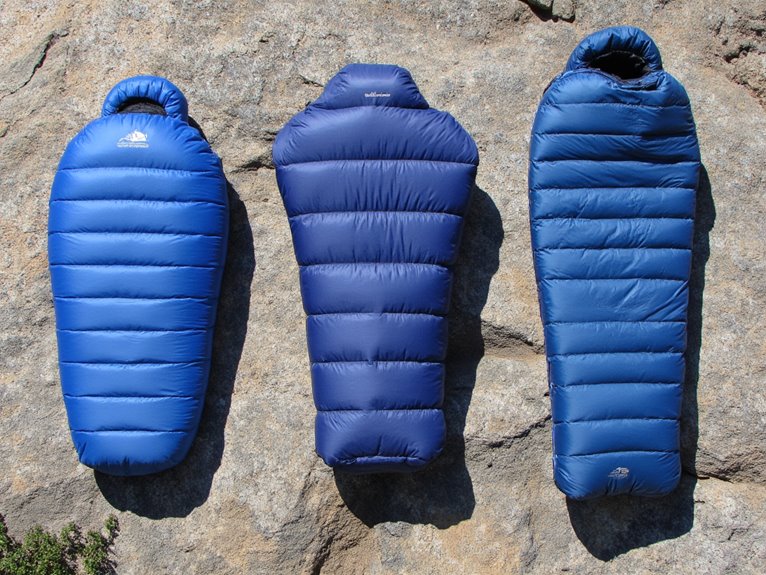
While weight and packability matter considerably, your sleeping bag’s shape and fit directly determine both thermal efficiency and sleep comfort throughout the night.
Mummy bags provide the highest warmth-to-weight ratio through their tapered design and snug fit. Semi rectangular fit offers increased movement space while maintaining notable thermal efficiency. Rectangular comfort maximizes room but sacrifices heat retention due to excess air space.
Your shoulder measurement plus ten inches determines ideal bag width. Choose a length slightly longer than your height—typically six feet for regular sizing, six-foot-six for long options.
Women’s-specific bags feature proportioned cuts for shorter torsos and roomier hips. Too tight compresses insulation and reduces performance. Too loose creates dead air space that cools rapidly, diminishing thermal efficiency and comfort.
Users should measure their height and choose the sleeping bag size accordingly, with recommendations to add 6-12 inches for comfort, where regular size suits heights between 5’6″ – 6′, long size fits individuals from 6′ – 6’6″, and short size is ideal for those under 5’6″.
Balancing Features, Quality, and Budget
Budget constraints shouldn’t force you to sacrifice essential performance features when selecting a backpacking sleeping bag.
Feature prioritization becomes critical when balancing cost against performance needs. High-fill-power down bags cost several hundred dollars but deliver superior warmth-to-weight ratios and compressibility. Entry-level synthetic options sacrifice weight and pack size but perform better in wet conditions at lower prices.
Smart shoppers target sale periods and previous season models for significant savings without performance loss. User reviews help identify the best price-to-performance balance across different brands and models.
Investing in bags with versatile temperature ranges reduces the need for multiple specialized bags. Focus your budget on features matching your specific backpacking style—ultralight construction for thru-hikers or durability enhancements for rough terrain use.
Consider adding a sleeping bag liner to your setup, as these $25-60 accessories can extend your bag’s temperature rating by 5-15°F while protecting it from body oils and sweat to increase its lifespan by 3-5 years.

